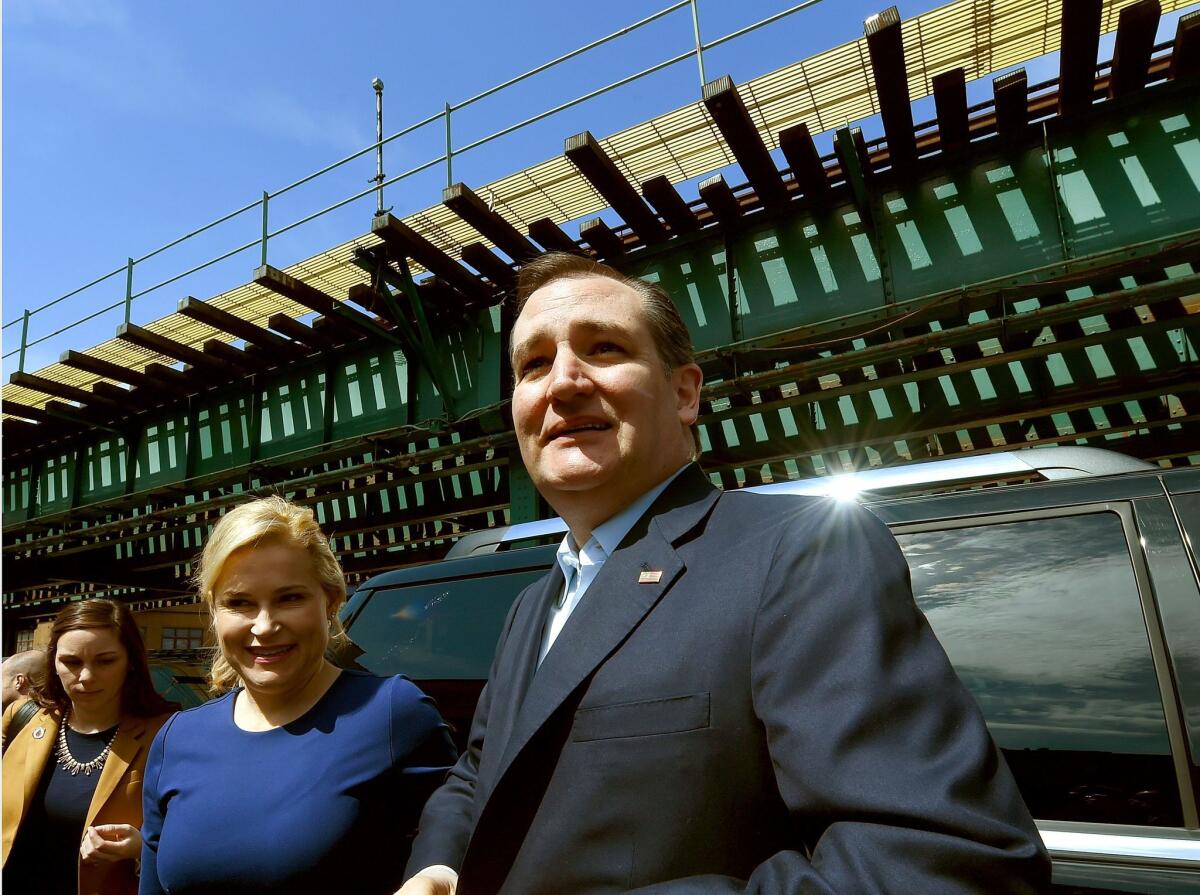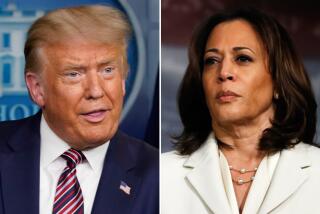CAMPAIGN SHOCKER! New York tabloids still have influence in presidential race

When Republican presidential candidate Ted Cruz and his wife, Heidi, campaigned in the Bronx recently, their visit sparked a memorable New York Daily News headline.
- Share via
Reporting from Washington — George Arzt has been around New York media long enough to know the presidential candidates were in for pain when they hit his city. Even he, however, a New York Post alumnus who went on to handle media for the late Mayor Ed Koch, has been astounded to see so many candidates resemble deer caught by headlights.
“Candidates come here, and they are thinking, ‘I just said this one little thing as an aside to a reporter and now it is a blaring headline. I don’t know how this happened,’” Arzt said. “They don’t understand this is a world unto itself. It’s nothing like the media in the rest of the country.”
The breakout stars emerging in the first competitive presidential primary in New York in decades have been not the candidates themselves, but the tabloids which pound them.
For more than a week, the front-page headlines of the New York Daily News and its competitor, the New York Post, have driven the media narrative in the run-up to next Tuesday’s primary with screaming messages like “TAKE THE F U TRAIN” (directed at Sen. Ted Cruz) and “BEST EX I EVER HAD” (flanking a photo of Donald and Ivana Trump).
Neither paper has a secure future – circulation has plunged and advertising all but disappeared – but they are relishing their moment.
Their role in the presidential race has dramatized a paradox of modern journalism: New York City leads the country in new media, but in no other place are public debates so routinely driven by old-fashioned newspaper headlines.
“The front pages of these papers were built to grab attention … and elicit some sort of emotion,” said Daily News Editor Jim Rich. “It is tailor-made for social media, which is nothing but a stew of wildly ranging emotions.
“In some ways it is surreal to see how well received and the type of impact these pages are having on digital.”
The tabloids’ ability to rattle candidates and shape the campaign debate shows how surprisingly well traditions of ink-stained, old-school journalism dating to the 1920s have adapted to the world of social media.
New Yorkers are so enamored with their headlines that an entire news program on NY1, a 24-hour cable news network broadcast to 2 million homes, is called “In the Papers.” It features a news anchor methodically flipping through the publications, highlighting stories of note.
Much about these tabloids has not changed in a century. Those conversation-driving headlines boldly printed across the cover are still called the “wood.”
And they remain blunt objects that can bludgeon an unwary politician.
Candidates ignore the rules of the tabloid game at their peril.
Veteran New York political consultant Hank Sheinkopf has three, each of which Hillary Clinton appeared to be following recently when she took reporters with her on a subway ride.
Rule one: Give reporters something to write about, so they don’t make your news for you.
Rule two: Make sure the news is real, which for Clinton it was in the wake of a gaffe by her rival, Sen. Bernie Sanders, involving subway tokens.
The third rule? “Expect anything to happen,” Sheinkopf said.
And it did. It took Clinton five tries to successfully swipe her Metro card at the turnstile. That’s a familiar frustration to New Yorkers, but no matter. Clinton was punished for it.
“This is like the song that doesn’t end,” Sheinkopf said. “Reporters will parse it and find new angles. You can’t hide.”
As Rep. Charles B. Rangel, the veteran Harlem Democrat, put it, the tabloid press “is a very hot kitchen, and it should be approached cautiously.”
After all these years, Rangel said, he has yet to find a recipe that doesn’t leave burns.
In the present campaign, the various candidates have provided a master class in what not to do.
John Kasich drew ridicule for eating a pizza with a fork and knife.
As for Cruz’s ill-fated visit to the Bronx -- “disaster is not the word for it,” said Arzt -- the event was so overshadowed by boos and jeers that it formed an irresistible target.
Everyone at the Daily News expected Cruz’s trip would create a good day for them. Just how much the gods of tabloid journalism were smiling on the newsroom became clear when the photos arrived.
“We had these pictures of Cruz and his wife standing underneath the elevated subway line that were just fantastic,” Rich said. “They looked like nervous tourists who had never set foot in the Bronx before. There was almost a ‘Bonfire of the Vanities’ thing going on,” he said, referring to Tom Wolfe’s 1987 novel, set in part in the South Bronx.
Arzt can’t imagine allowing such a scene to occur.
“It was catastrophic,” he said. “If I was his advance man, I would have shot myself.”
Nor can he believe how Sanders’ aides allowed him to walk into the News editorial board meeting so unprepared that he bobbled questions on signature New York issues he has been talking about for months: Wall Street, guns and Israel.
Indeed, despite all the cheeky headlines, the gotcha moments and the spotlight on the trivial, the tabloid staffs have proved themselves intimidating policy wonks. The unrelenting grilling Sanders got from the editorial board over his plans to break up the big banks left the candidate with deep bruises.
“When you are trying to pass off some B.S. as fact, we are going to call you on it no matter who you are,” said Rich. The transcript of that interview went viral online. It stayed at the top of the news cycle for days and continues to haunt Sanders.
“Candidates mistakenly think some newspapers are more serious than others,” said Kathleen Hall Jamieson, a professor at the University of Pennsylvania who has written extensively about how the media covers presidential candidates.
“I could not imagine Sanders going to a New York Times editorial board meeting and not being prepared for it.”
But when an arcane but locally important issue like banking regulation becomes central to the race, as it has this year, it is the tabloids that can most influence votes, Jamieson said.
“These are the papers that are going to make sense of this for the average subway rider, the people the candidates are trying to mobilize,” she said. “The New York Times readers, the Wall Street Journal readers are less likely to shift their opinion. Their minds are already made up.”
Election 2016 | Live coverage on Trail Guide | Track the delegate race | Sign up for the newsletter
Rich has the predictably thick skin of a tabloid scribe. But he takes exception to charges by some Sanders backers that his paper, which announced its endorsement of Clinton on Wednesday, is in the tank for her. He insists the critics give a scan of the paper’s recent “wood.” It has not been kind to the former secretary of State.
“SKIT FOR BRAINS” was emblazoned on the cover Tuesday over a photo of Clinton and New York Mayor Bill de Blasio performing a theatrical skit, which included a joke about running on “cautious politician time” that some perceived as an insensitive takeoff on old, racist jokes.
The paper’s favorite villains in the race, though, are undeniably Cruz and Donald Trump. The New York tabloids have been selling papers off Trump’s exploits for decades. The New York billionaire knows the game, and often relishes it.
So does his first former wife. Ivana told the Post she was all for immigrants who come to the country legally.
If not for them, she said, “who’s going to vacuum our living rooms and clean up after us?”
For more on Campaign 2016, follow @EvanHalper
ALSO
Three candidates vie for bragging rights: Who’s the real New Yorker?
Trump’s clash with Las Vegas union highlights his unpredictability
Trump, Cruz and Kasich lay the groundwork for crucial California race
More to Read
Get the L.A. Times Politics newsletter
Deeply reported insights into legislation, politics and policy from Sacramento, Washington and beyond. In your inbox three times per week.
You may occasionally receive promotional content from the Los Angeles Times.











